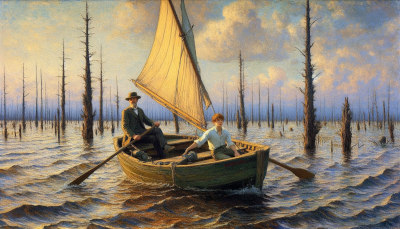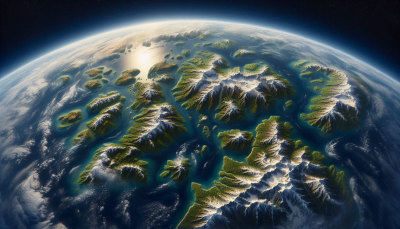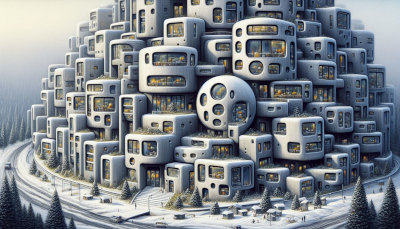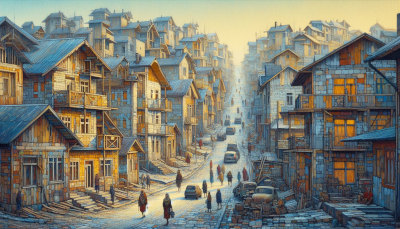The Indigo Jewel
Chapter 11 - The Great Divide
Intro,
1,
2,
3,
4,
5,
6,
7,
8,
9,
10,
11,
12,
13,
14,
15,
16,
17,
Epilogue,
Afterward
In the years following the collapse of civilization around the end of the twenty-first century, humanity entered a dark period. Many perished from heat, hunger, and thirst. The wealthiest fled north or south by ship, leaving the poor to endure the catastrophe. This created the Great Divide.
Portland was once a thriving community where you could buy anything with a swipe or a tap. Now, it is a drowned relic of the past. The sea has claimed most of the city, submerging neighborhoods and iconic bridges. The Willamette River has merged with the Pacific, and the Columbia, once mighty, is now a broad bay filled with the skeletal remains of tall buildings, abandoned ships, and freeways that disappear beneath the waves.
Joshua sat near the bow of their small sailboat, rowing the oars as his father, Romero, examined the horizon. The wind carried the briny scent of the expanded coastline, where the ruins of downtown lay partially submerged. Only the highest points—the West Hills, Mount Tabor, Mount Scott, and a few scattered towers remained above water. Any exposed land is covered with dead trees.
“Look at that,” Romero muttered, gesturing toward the remnants of a home jutting from the water. “There are demolished houses all over the side of that mountain. Is that Mount Scott?”
Joshua shaded his eyes. “It's hard to say.” He had never known Portland as it was before. To him, it had always been a place of ruin, a waypoint in their seasonal migrations.
They were Travelers, moving north in the summer to escape the deadly heat and then south in the winter to work on salvage operations. The seasons were cruel, but there was still work to be found - harvesting metal, searching abandoned houses, and occasionally finding artifacts that were worth trading in the north.
Romero looked at the sky wondering if it ever rains here. “People who survived here had to go underground. Literally. There are isolated groups on higher ground. Dug out, insulated, cool enough to live in. Some folks communicate by HAM radio, but otherwise, this place is cut off.”
Joshua nodded. He had seen a few of the underground shelters firsthand. Some were old underground parking garages converted into bunkers. Others were elaborate networks of tunnels. These people had adapted, avoiding the scorching sun and scavenging supplies in the cooler months.
Romero continued, “I heard on the radio last week that a few tried to enter the Arctic Zone in Canada. But they won’t take just anyone.”
Joshua grimaced. “If you don’t have a skill they need, you’re out of luck.”
“Or worse,” Romero added darkly. “You saw what happened to those folks last year who tried to cross the barrier without permission.”
Joshua said nothing. The memory was still fresh.
As they sailed north along the submerged remnants of Highway 205, they passed the tops of lamp posts and the occasional crumbling rooftop. This was the coastline now, impossible to recognize on an old map. The remains of bridges loomed just beneath the surface, treacherous to unwary sailors.
They found a sheltered inlet and docked for the night, tying their boat to a piece of exposed metal that once belonged to a highway overpass. As darkness fell, they scanned the radio for news. A crackling voice spoke of camps in Canada and Alaska, of crops growing on the thawed tundra, and of a government still clinging to order in the Arctic Zone.
Joshua listened in silence, then turned to his father. “You always say we should keep moving, but someday there won’t be anything left to salvage.”
Romero looked at his son, his face lined with years of hardship. “Maybe. But not yet. There are a few good years left. We are never going to get into the Arctic Zone, so we have to keep moving.”
Joshua lay back, staring at the stars. The Great Divide had changed everything. The north and south had carved out their own ways of life, but in between, the world was a wasteland.
He wondered if the divide would ever be healed.
The people who made it to northern Canada and Alaska are building homes, and stores are supplying basic goods and survival needs. The government of the United States has moved to Alaska. There are no marble columns here, but things are much better than the desert they left behind. Here things are tolerable. Here there is enough food to survive, and here the largest industry is salvaging building materials from the uninhabitable regions to the south. The best materials are found along the coast, though materials in the newly submerged regions are hard to get to. For the first few years after the Arctic Zone was established, over half the population was involved in this salvage effort. The housing and office buildings created with the salvaged material are functional but not attractive.
By 2110 the Arctic Zone has become the largest concentration of humanity on Earth with about 120 million souls living in regions controlled by the countries of the northern hemisphere. The United States and Canada are cooperating closely to survive. Russians are living all along the Siberian coast. The Chinese have purchased Greenland from Denmark and moved their richest and most educated people there in a massive effort. The European Union is concentrated in Scandinavia. It is a motley group of countries and they do not get along very well. There is currently a cease-fire that seems to be holding between Alaska and Russia.
In a positive development, people have planted billions of trees across the land that was previously frozen tundra. The scientists say this is very important to make up for the rainforests which were lost.
Meanwhile 20,000 kilometers to the south…
The Antarctic Zone stands in stark contrast to the north. The people here had to cross a dangerous ocean to get to their new home. The journey was not easy, and it is often impossible to go back. The people of the south have concentrated their salvage efforts in two areas: saving plants and animals from extinction, and saving as much technology as possible. Many species from the Amazon have been transplanted. The organization dedicated to saving endangered life has also brought species from Africa, south Asia, Indonesia and the rest of Oceania. Zoos have managed to save species from all over the planet when they brought their entire collections with them. Because of the long dark winters, giant greenhouses have been constructed encompassing entire valleys. They are illuminated and warmed by geothermal power.
At the South Pole the land is mountainous. The high elevations are covered with snow and not useful for other purposes. This is where the frozen seeds and embryos have been stored. From the mountainside workers carved out a cavern and built a giant vault. It is patterned after the Svalbard Global Seed Vault in the north.
The mountainous region near the center of the country is only inhabited by creatures from the polar regions of the north and south. They are kept in separate areas so vulnerable species can survive. They even have several of the wooly mammoths that were resurrected in the last century. Management of the giant zoos and wildlife parks is done by a small dedicated staff. It is a very popular job.
The people here believe they are holding on to the best of the core values and beliefs that existed before the Great Divide. The Antarctic population is less than half of the Arctic population and this is intentional. They have designated over half the available land in the south as nature preserves. Much of the soil has been scraped off by the glaciers and the continent is now composed largely of islands due to the rise of the oceans. There are a few good farming areas like New Perth and Singapura Baharu, but most areas don’t have deep soil. So, efforts are concentrated on small manufacturing and vertical farming to meet their needs. There are several good mines on the continent and they supply the raw materials needed.
Two fusion reactors power the entire country. The people on the continent have formed a single government and they are dedicated to avoiding the mistakes of the past. Everyone is working together to keep their country, which they call “Ant”, safe and moving toward stable and sustainable consumption. They don’t want to lose their new home, and they believe they cannot survive without saving the plants and animals too.
Communications between the Arctic and Antarctic Zones have been cut off for several years due to the enormous distance and the uninhabitable region between them. In this dead zone, the daytime temperatures are simply unbearable for plants and animals. It is a vast desert and the scientists think it will remain that way for at least a thousand years. Or until the excess carbon dioxide is somehow removed from the atmosphere and ocean.
Copyright © 2025 Elton Smith



